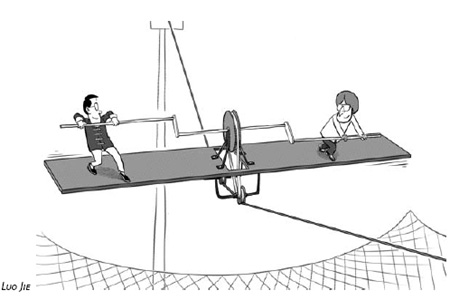After 60 momentous years, their ears should be attuned
China-India relations are at a critical stage. This year, they will celebrate the 60th anniversary of their diplomatic relations, and as Confucius has said: "At sixty my ear was attuned." That is to say, when a person turns 60, he or she becomes wise, starts thinking about others' positions and becomes sensitive to their difficulties and concerns. In its 60th year, the Sino-Indian relationship should take inspiration from Confucius.
China-India ties were defined in 2005 as "a strategic and cooperative partnership for peace and prosperity". To me, peace means the two sides do not regard each other as threats; the world is big enough for both of them to grow together. Prosperity means the two sides welcome each other's growth and share the common task of national development.

I agree with what India's Foreign Secretary and former ambassador to China, Nirupama Rao, wrote in January 2009: "Ours is a complex and multi-layered relationship There will always be overlaps between competition and cooperation."
Most people would agree that the Sino-Indian boundary dispute is not likely to be resolved in a short period, because the two sides have widely divergent positions on the issue. But the boundary question is not everything in their relationship. So it would be reasonable to leave the dispute to border talks' representatives.
In other words, the two sides should segregate the question and tackle it within the existing negotiations' mechanism.
It is unimaginable that the China-India border dispute can be resolved by force. When former Indian prime minister Rajiv Gandhi visited China in December 1988, the two countries wisely decided not to let the boundary question hold back bilateral relations from realizing their true potential in other spheres. It was indeed a pragmatic and farsighted decision and would help the two Asian giants to avoid falling hostage to the boundary dispute. That is why Rajiv Gandhi's visit remains a defining point in Sino-Indian relations.
Economic cooperation is widely believed to be an important pillar supporting bilateral relations. It is natural for economic friction to grow with increasing bilateral economic contacts. But economic friction is better solved in economic and mutually beneficial ways. There is no point politicizing them.
The two countries should meet (or almost meet) the target of their $60-billion bilateral trade volume this year. It may not be a milestone in bilateral ties, but it would show the world that China and India have the wisdom to walk hand-in-hand to achieve their goals.
Chinese companies are growing increasingly frustrated with India's "flip-flop" policy even after they were "welcomed to bid in an open market". Their frustration, too, can be dispelled through frank discussions and mutual understanding and benefit.
The media have played a very important role in driving the China-India relationship, given the fact that the two countries are still haunted by some unpleasant memories. The squabble between the two neighbors last year can be traced to some sensational and irresponsible reporting by the media. Some hawkish Indian newspapers and TV channels made it look like the two countries were hovering on the brink of a war. When I raised the question of "media courage" during my recent visit to India, some Indians on the street laughed it away.

It cannot be ruled out that some government sectors do occasionally use the media to test a balloon, but top-level decision-makers should never let a section of the media or public voice to lead them by the nose. Fortunately, the Chinese and Indian governments both have chosen not to be involved in the media hullabaloo.
After considering everything, I think the recent war of words is natural, because it indicates that the two simultaneously emerging giants are experiencing some "growing-up pains". It will take some time for them to adjust psychologically and accommodate each other's ascent. The challenge is how to maintain the momentum of bilateral cooperation without necessarily agreeing on everything.
Some would ask why it is so easy to spread misperceptions. This can be explained by the sluggish people-to-people contacts between the two. In this increasingly interdependent world, non-officials such as academics, retired civil servants and military officers, public figures, social activists and tourists can play a very important role in boosting bilateral ties. But only 530,000 people - 460,000 Indians to China and 70,000 Chinese to India - were part of the bilateral exchange in 2007.
On the 60th anniversary of their diplomatic relations, China and India have the opportunity to learn from history and look to the future. A healthy and cooperative relationship is in both sides' interest and good for amicable regional and global cooperation. There will always be overlaps between competition and cooperation in a mature China-India relationship. To take bilateral ties to a new level, both sides have to create as much common ground as possible.
The neighbors, both with thousands of years of civilization, have a lot to learn from each other. They have every reason to set up a new analytical framework of international studies with the wisdom of "Eastern Civilizations". Greater awareness of each other's concerns and aspirations is an essential building block for mutual trust. If a thinking is dominated by geopolitical mindset, it will remain stagnant. New thinking is the precursor to progress.
The last two years of bilateral interaction have proved bilateral tensions have to be defused before they rise too high. Once public opinion tilts dangerously to one side, leaders will have less room to make rational decisions. Disputes and quarrels easily attract attention, but healthy cooperation and "attuned-ear" manners determine the future.
China and India share common tasks and aspirations, which are indeed very thorny jobs. Therefore, "let us meet together, let us talk together, may our minds comprehend alike," just like a hymn from the Rig Veda, India's oldest philosophical text, says.
The author is deputy director of Center for South Asian Studies, China Institute of International Studies.
(China Daily 01/04/2010 page9)


















